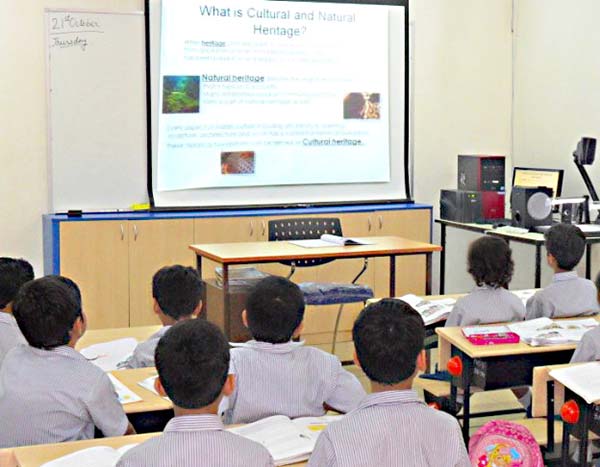While the smart classrooms and the Skype teaching are two parallel forms of digital education, teachers caught between unrest and examinations tagged the two to help the smart kids, reports Umar Khurshid

The classrooms that our grandparents went to were exactly the same that our generation was taught in: Chalk and blackboard, a packed classroom, text books, regimented curriculum, a teacher painstakingly explaining abstract concepts with the limited tools at their disposal.
But now it is the era of smart classes. These have transformed the classroom, albeit a few. Now the science teacher while explaining how a DNA replicates is able to show his students a 3D animation of the entire process on a large screen. She can explain the fine points of the process, zoom in to show the relevant visuals freeze and annotate when and where they need to emphasize.
Digital classrooms have emerged the most effectively used learning solutions in certain Kashmir schools in a short span of time. Due to the innovative approach, layered structure and pedagogy, the trend has been appreciated.
Barring a few exceptions, the trend is essentially a post-2016 entry. The unrest locked the schools for almost half of the year. After the normalcy returned to the streets, and schools reopened, the smart classroom trend took off.
Smart Classes were introduced which are gradually transforming the conventional classrooms to an advanced student-centric online learning environment. The learning solutions are created by highly experienced teachers with a better teaching background.
A numbers of schools in Islamabad have come up with the smart classes teaching style which includes Skype an android application also. By the fag end of 2016 unrest, the trend of smart classes or digital classes was adopted by various schools.
Skype online teaching is a service with a webcam and handset, through which students can have person to person or person to group chats, conferences with instant messages. Students during the video call/chat can ask any question regarding their subjects to the concerned users of an application which is directly linked to the live teachers present, with the help of a projector or a screen placed on the wall in the real classroom. Credit goes to the internet for the entire technology that classrooms are adopting fast.
What makes the smart classes different is that the technology brought an exhaustive repository of world-class digital modules or lessons, (consisting of 2D and 3D animations, graphics, audio, and video) to the students, some of whom may not have even dreamt about.
The only difference between Skype teaching and smart class teaching is that the Skype connects with internet and smart class has pre-installed apps. “I usually use symbols and animated series of figures on smart board to make it easy for students to understand the equations, gene and plant processing etc,” says Mushtaq Ahmed lecturer Botany from Girls school Islamabad.
Insha Abbas is the head-girl of twelfth class in state-run Girls School in Islamabad. Initially, she said, it was a bit harder to sit in a smart classroom. “After a couple of trials and examples given by the teachers, it is the easiest way to study and understand the complex things,” she said.
Mushtaq Ahmed Rather is a lecturer teaching Botany in the same school. “With the help of an android app called Skype and smart classes, we are reaching to the roots of the students to test their knowledge and make them focus more on their studies,” he said. “It has become very easy for our students to run with the least time and cover the syllabus portions.”
Sakhi, a student, said they used this technology in late 2016 and managed part of the deficit.
Rabia 18, a twelfth class student of Girls School, Islamabad said while computer and internet service was already available in her school, the addition of android app has helped her a lot to cover part of the syllabus. “Earlier students used to get bored during the class, but through an app and smart classes they have started video presentations which are interlinked with YouTube as well,” she said. The new generation obsessed with technology is readily accepting the new teaching fad.
An app teacher, Ferrijan from Ranibagh School in Islamabad said that the students have got a good hold on the language after they started attending smart classes. There is less staged fear observed among them.
Ferrijan said they have hundreds of students from ninth standard who take Skype classes and twelfth standard students who study through smart classes. “Smart classes helped us during tight times when there was less teaching staff available in the school,” he said.
Rizwan, a class 12 student of Islamabad’s Boys Higher Secondary School said, the app helped them cover syllabus quickly. “It gives us a new freedom,” he said. “We can watch educational videos and make calls.”
Some private schools and colleges have embraced the technology. A few state-run schools followed the suit quite recently.
“Being in a conflicting zone we go through problems every another day, but I usually guide my student to come to class and use this android app and explore the smart classes,” Ferrijan, said. “Administrations always prefer students from ninth standard to use this app because it helps students to get used to the new trend and keep their hold on the language and digitalisation. “It is emerging as the new effective tool for teaching students using the best teaching material in the world,” she added.















